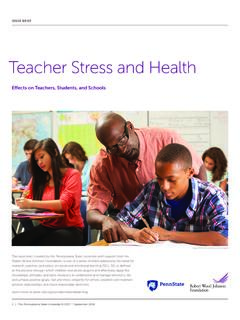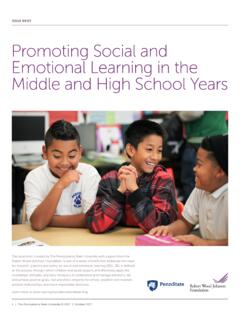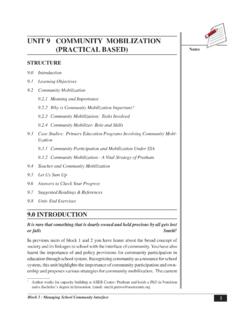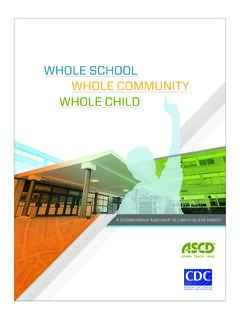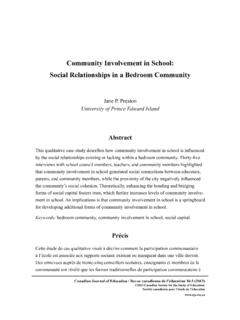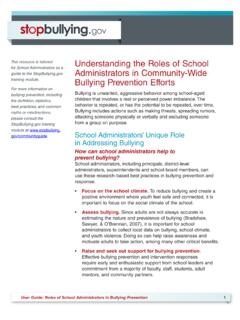Transcription of Supporting School Community Wellness with Social and ...
1 Issue brief The Pennsylvania State University 2020 | August 2020 Supporting School Community Wellness with Social and Emotional Learning (SEL) During and After a Pandemic This issue brief, created by The Pennsylvania State University, is one of a series of briefs that addresses the future needs and challenges for research, practice, and policy on Social and emotional learning (SEL). SEL is defined as the process through which children and adults acquire and effectively apply the knowledge, attitudes, and skills necessary to understand and manage emotions, set and achieve positive goals, feel and show empathy for others, establish and maintain positive relationships, and make responsible decisions. This is the second series of briefs that address SEL, made possible through support from the Robert Wood Johnson Foundation. The first set synthesized current SEL research on early support for parent engagement and its effects on child outcomes; SEL in infancy/toddlerhood, the preschool years, the elementary School period, and the middle-high School timeframes; and how SEL influences teacher well-being, health equity, and School climate.
2 Learn more at: Cipriano, , Yale School of Medicine; Gabrielle Rappolt-Schlichtmann, , EdTogether; Marc Brackett, , Yale School of Medicineissue brief 2 | The Pennsylvania State University 2020 | August 2020 Executive SummaryWhen COVID-19 descended upon the nation in March 2020, schools across the country quickly turned to Social and emotional learning (SEL) to seek guidance to support all School Community members efforts to thrive. School closures required a rapid transition to remote learning amid unprecedented and disproportionate experiences of loss that intensified existing educational inequities. Coinciding with the pandemic, the violent murders of George Floyd, Breonna Taylor, and Ahmaud Arbery, followed by tense nationwide protests, awakened a longstanding need to support racial justice, foster equity, and dismantle structural racism. These Social conditions and experiences of loss have presented challenges to Wellness that continue to weigh heavily on the physical and mental health of educators, students, and families, especially for Black, Indigenous, and people of color (BIPOC) communities and among those with disabilities.
3 When implemented with fidelity, SEL provides a foundation for resilience that benefits all members of a School Community , Supporting greater student engagement, Social -emotional health, and academic achievement in addition to increasing engagement and well-being among educators, School leaders, and families. What have we learned from high-quality SEL implementation and prior crises that can help prepare School communities for what s to come? And what have we learned from the disproportionate experiences of this pandemic in underserved and marginalized communities to chart our way forward? In this brief we explore the role of SEL in promoting Wellness during the compounding traumas of a pandemic. We identify Bright Spots examples of how SEL research and practice are being applied to support Wellness during this crisis and that may be used in related crises moving forward, and Ripe Spots opportunities for SEL to support the anticipated needs of schools toward the promotion of School Community Wellness .
4 Key Points lUnprecedented and evolving challenges to Wellness should be informed by attention to the research and systematic implementation of SEL. lEducators are applying SEL strategies to address the pandemic s disproportionate impact and support students and teachers during distanced educational experiences. lSEL can contribute to the system of support for a School Community to acknowledge the compounding traumas of the pandemic and navigate the anticipated needs of School communities in the current School year. In this brief, the School Community refers to all stakeholders in the School , including School leaders, teachers, and support staff, students, their families, and Community program partners. Further, Wellness refers to the broader physical and psychosocial well-being of the School Community and all of the individuals within it. We explore how SEL has the opportunity to promote the conditions for School communities to thrive as part of the broader ecosystem of supports and services necessary to mobilize and respond to inequities and promote Wellness through the pandemic and thereafter.
5 Issue brief 3 | The Pennsylvania State University 2020 | August 2020 The COVID-19 Pandemic Disrupted the School Year and Exacerbated Existing Inequities Our School communities are in crisis. The COVID-19 pandemic swept across our country swiftly and with little time for preparation in March 2020, requiring necessary and urgent closures of non-essential industry, including most institutions of The emotional lives of students, educators, and families demonstrated the need for intervention and support for School Community Wellness . According to a national survey of 3,300 adolescents, since the closing of School buildings, nearly 33% had feelings of depression and anxiety, and more than 25% reported a lack of connection to peers, teachers, and School Just two weeks into the pandemic, more than 5,000 teachers reported feeling anxious, fearful, worried, overwhelmed, and sad, with anxiety by far the most frequently mentioned Relatedly, a survey of over 1,000 urban School leaders in late April revealed findings strikingly similar to those for Not surprisingly, parents and caregivers reporting high levels of stress shared an elevated stress response.
6 In response to another pandemic survey, families with young children reported a 67% increase in feeling anxious or depressed all day, a 42% increase in their children s externalizing behaviors, and a significant decline in family mental health from March to June reasons given by students, educators, and families for these stress-related feelings fall largely into two domains. The first is health-related, including a general fear that they or someone in their family may contract COVID-19 or have their physical health jeopardized. The second is anxiety about the management of the day-to-day, including Supporting their own and their families needs while simultaneously working full-time from home and adapting to new technologies for teaching and Leaders share the additional stress of knowing the gravity of their decisions and their impacts on the School Students further report anxieties that extend into concerns about their future education, college, and career Although the ripples of the pandemic s impact continue to unfold while we prepared this brief,7 what is certain is that the effects are being felt differently across every household and School Community in the The pandemic s disproportionate impact on Black, Indigenous, and people of color (BIPOC)
7 , persons with disabilities, and the elderly, and its interface with income, education, and health infrastructures, has flashed a bright light on current and persistent systemic inequities in our ,10 HealthWith regard to health, BIPOC have been more likely to report significant stressors than their White peers, namely in contracting coronavirus (71% vs. 59%, respectively), meeting basic needs of food and shelter (61% vs. 47%), and having access to health care (59% vs. 46%).11 Of all racial groups, as of late July 2020, Black Americans continue to experience the highest overall COVID-19 mortality rates about times as high as the rate for White issue brief 4 | The Pennsylvania State University 2020 | August 2020 Social conditions, structural racism, confounding pre-existing comorbid conditions, and barriers to health insurance and care all elevate the risk for COVID-19 diagnoses and deaths in BIPOC Further, although typically developing children have demonstrated resilience to the coronavirus, children with developmental disabilities under the age of 17 have the same death rate as people over age 75, who had the highest death rates of all LearningWith regard to learning, parents from low-income homes are 10 times more likely to report little or no remote learning in their home.
8 with 33% of parents feeling very concerned about children falling behind. Conversely, only 1 in 5 high-income families are concerned about learning loss. Moreover, students with disabilities are more likely to have their education services disrupted than general education students, with reports as staggering as 1 in 5 receiving the services they are entitled to under the Individuals with Disabilities Education Act (IDEA) and more than 33% doing little to no remote learning compared to about 10% of their general education peers. Further, 40% of parents of children with special education needs are concerned about their children s mental health, compared with just over 20% of parents of neurotypical know that prior to COVID-19, mental health issues were prevalent among Americans. Nearly half of all children are estimated to have experienced at least one Adverse Childhood Experience (ACE),15 more so among youth of color and those growing up in low-income And nearly half of all educators report high levels of daily stress prior to this pandemic, with 30 50% of educators leaving the profession in the first five years, citing stress and burnout as leading It has been well established that confounding threats to safety, such as racism and Community violence, as well as the absence of supportive relationships, create conditions that make people more susceptible to experiencing levels of toxic stress that can have pervasive, negative impacts on their bodies and Childhood Experiences (ACEs)
9 Are experiences such as physical and emotional abuse, neglect, caregiver mental illness, and household violence, that can contribute to poor developmental outcomes for children across their lifespan. Learn more at Harvard University s Center on the Developing also know that COVID-19 poses a significant threat to the mental health of School communities now and in the long term. Although this pandemic experience is novel, when examining research on prior crises and health-related disasters, we learn that 25% of isolated or quarantined children and adults experienced post-traumatic stress Additionally, we know the mental health of parents and caregivers also has direct implications for their children s brief 5 | The Pennsylvania State University 2020 | August 2020 The intersection of these evolving health, income, and education inequities is devastating, but not inevitable.
10 In this brief we explore how SEL, when implemented systematically and as part of the broader and coordinated ecosystem of essential supports and services, can contribute to School Community preparedness and promote conditions for ,20 Social and Emotional Learning (SEL) is the modeling and teaching of an interrelated set of cognitive, affective and behavioral competencies that underscore our capacity to learn, develop, and maintain mutually supportive relationships, and be both physically and psychologically According to the Collaborative for Academic, Social , and Emotional Learning (CASEL), SEL comprises five interrelated competencies: Self-Awareness, Self-Management, Social -Awareness, Relationship Skills, and Responsible Decision Making. Learn more at brief 6 | The Pennsylvania State University 2020 | August 2020 From Reaction to Prevention: SEL as a Critical Component of School Community PreparednessWe are writing from a place of hope.


